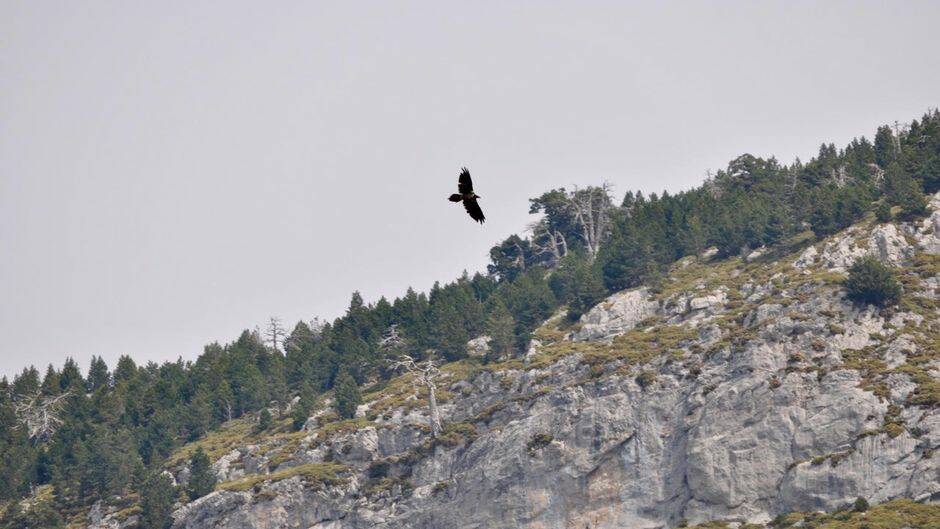After other predators have consumed the soft parts of their prey, the bonebreakers arrive to feast on the skeleton. They are capable of swallowing and digesting 20 cm long pieces of bone.
 Bonebreaker. / Photo: Antonio Cruz.
Bonebreaker. / Photo: Antonio Cruz.
But these you may not eat: the eagle, the vulture, the black vulture, 13 the red kite, the black kite, any kind of falcon.
(Dt. 14:12)
The Hebrew term peres, which literally means “breaker”, only appears twice in the Old Testament (Lev. 11:13; Det. 14:12) and in both cases it refers to the same animal, unclean for the Jews, the bearded vulture or “bonebreaker” (Gypaetus barbatus).
It is a strong rapacious bird of the Accipitridae family, with a long diamond shaped tail, and it flies by occasional but deep and slow wing-movements, which enables it to hover for long periods without any perceptible movement of its wings. Unlike other vultures, the bearded vulture’s head is covered with feathers. This is because, contrary to the practice of other species, it does not bury its head in the dead animal’s carcass. In the case of young specimens, the feathers on the head are black, but in that of adults they turn white. It has a fringe of black feathers around its eyes which converge near its beak forming a kind of moustache that hangs down on both sides of the beak.
The common name “bonebreaker” comes from its habit of taking bones or tortoise shells and dropping them from a great height with the aim of shattering them as thy break against the rocks. They are the only birds that can actually eat bones (osteophage). After other predators have consumed the soft parts of their prey, the bonebreakers arrive to feast on the skeleton. They are capable of swallowing and digesting 20 cm long pieces of bone. If they are bigger than that, they drop them from the air and break them in smaller pieces so as to be able to swallow them. They also feed on mice and small lizards which they hunt down wile flying.
The bonebreaker is an endangered species, protected and reintroduced in some parts of Europe (the Pyrenees and the Alps), although there are still specimens in North Africa, the Great Rift Valley, South Africa, Greece, Turkey and even the Himalayas. In Israel it has been extinct for many years, though it seems that there were some ornithologists who observed young specimens of the bird in 2016, flying over the Dead Sea.
Its full wingspan can be up to 3 metres, and it weighs between 4.5 and 7 kilos. The reddish yellow colour of the chest feathers of some specimens of the bird results from its habit of bathing in mud that is rich in iron oxides, but their actual colour is white. They communicate with each other especially by moving their eyes and bristling the plumage of their head. The iris of their eyes is yellow and the sclera red, but when they are aroused the latter flares up and becomes even redder than usual, and their head feathers bristle.
Bonebreakers build their nests in steep cliffs with caves, where there are many animal skeletons. If bones become unavailable, they can abandon their nests and return later with their prey. They can fly over areas of up to 30 km2 in search of food.
Each male specimen mates with just one female, when they reach sexual maturity, and they remain together for the rest of their lives. The female usually lays a couple of eggs in the nest, which either the male or the female can hatch. However, neither parent will intervene to prevent the stronger of the two chicks from killing the weaker. Eagles also do this, and it is a behaviour that is particularly prevalent at times of food shortage.
The causes of the near extinction of this unique bird in many countries are illegal hunting, toxic bait, electrocution in high voltage nets, accidental collision with electric cables, the growing presence of human beings in mountain areas, as well as the decline of livestock farming, among other factors.
There are two known subspecies of bonebreakers: one of which inhabits the mountains of northern Spain, northwest Africa and the centre of northeast China (Gypaetus barbatus barbatus); and the other eastern and southern Africa, as well as southwest Arabia (Gypaetus barbatus meridionalis).
The way in which men and women in ancient times saw and understood animals was very different from that which prevails nowadays. However, there are feelings which have changed very little. It is evident that the affinity that one feels with a dog or cat is profoundly different from any feelings one might have towards the fleas that are liable to live as parasites in our pets, even though they both have animal life in common. In the same way, for humankind in Bible times there was also a similar affective ambivalence. The shepherds were connected to their sheep, and their sheep knew their voice (John 10:27), but, wolves, bears and hyenas on the other hand were threats against which they had to fight in order to protect their domesticated livestock.
Despite this reality, although the animal world is divided for Hebrews between clean and unclean, kosher and non-kosher, there is no doubt that as creation is of divine origin, there is a universal communion between all the living organisms of nature.
The words uttered by Peter in the New Testament: Do not call impure anything that God has made clean (Acts 10 v 15) confirm this truth. Consequently, from the perspective of the Christian faith, respect for the human being and their unique dignity must extend, proportionately, towards all the living creatures of creation.

Las opiniones vertidas por nuestros colaboradores se realizan a nivel personal, pudiendo coincidir o no con la postura de la dirección de Protestante Digital.
Si quieres comentar o